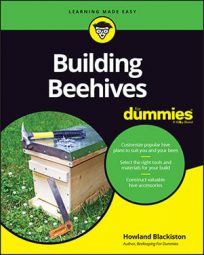The following tables break down the four-frame observation hive into its individual components and provide instructions on how to cut those components.
Lumber in a store is identified by its nominal size, which is its rough dimension before it’s trimmed and sanded to its finished size at the lumber mill. The actual finished dimensions are always slightly different from the nominal dimensions.
For example, what a lumberyard calls 1 inch x 8 inch lumber is in fact 3/4 inch by 7-1/4 inch. In the following tables, each Material column lists nominal dimensions, and each Dimensions column lists the actual, final measurements.
This hive requires dado and saw kerf cuts.
Hive body and top
| Quantity | Material | Dimension | Notes |
|---|---|---|---|
| 2 | 1" x 8" knotty pine | 10-7/8" x 5-3/4" x 3/4" | These are the side panels. Dado a 3/4" wide by 3/8" deep channel along the entire inside top width of both side panels. Make the dado cut 3/4" down from the top edge (the four frames rest on the ledge this dado creates). Drill an entrance hole 1-1/2" in diameter, centered left to right, and positioned ¼" from the bottom edge of one of the side panels. This is the entrance for the bees. Drill a 1-1/2" ventilation hole centered left to right and top to bottom on both side panels. |
| 2 | 1" x 8" knotty pine | 5-3/4" x 1-3/4" x 3/4" | These are the hive’s handles. |
| 1 | 1" x 8" knotty pine | 18-3/4" x 5-3/4" x 3/4" | This is the top panel (roof) of the hive. Drill a feeding hole 3" in diameter through the top, centered on the board. This hole accommodates the lid of the feeding jar. |
| 3 | #8 hardware cloth | 4" x 4" | This screening is attached to the top panel (roof) and to the ventilation holes in the side panels. |
![[Credit: Illustration by Felix Freudzon, Freudzon Design]](https://www.dummies.com/wp-content/uploads/356460.image0.jpg)
Credit: Illustration by Felix Freudzon, Freudzon Design
Bottom board
| Quantity | Material | Dimension | Notes |
|---|---|---|---|
| 2 | 1" x 8" knotty pine | 7-1/4" x 1-3/4" x 3/4" | These are the “feet” of the bottom board. |
| 1 | 1" x 8" knotty pine | 22" x 7-1/4" x 3/4" | This is the bottom (floor) of the hive. Cut saw kerf grooves, 1/8" wide and 1/4" deep, along the entire long length of the bottom board, centered and placed 5-3/4" apart. These grooves hold the bottom of the glass panels in place. Check the fit of the glass panels in the grooves before assembling the hive; adjust the kerf cut if needed to accommodate the thickness of the glass. The fit should be snug. |
![[Credit: Illustration by Felix Freudzon, Freudzon Design]](https://www.dummies.com/wp-content/uploads/356461.image1.jpg)
Credit: Illustration by Felix Freudzon, Freudzon Design

